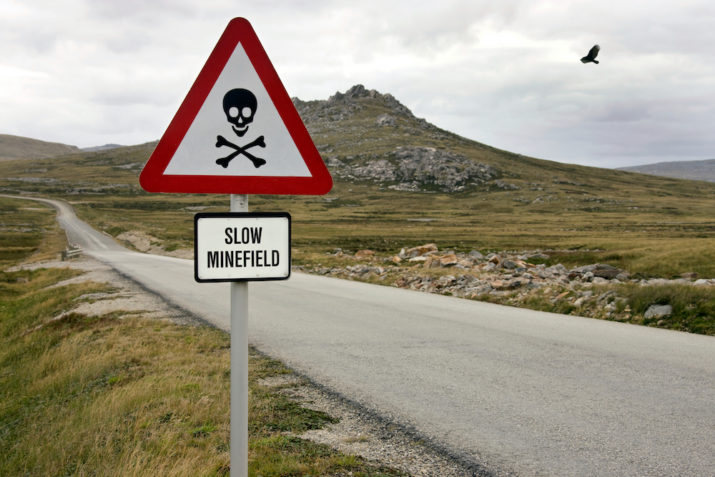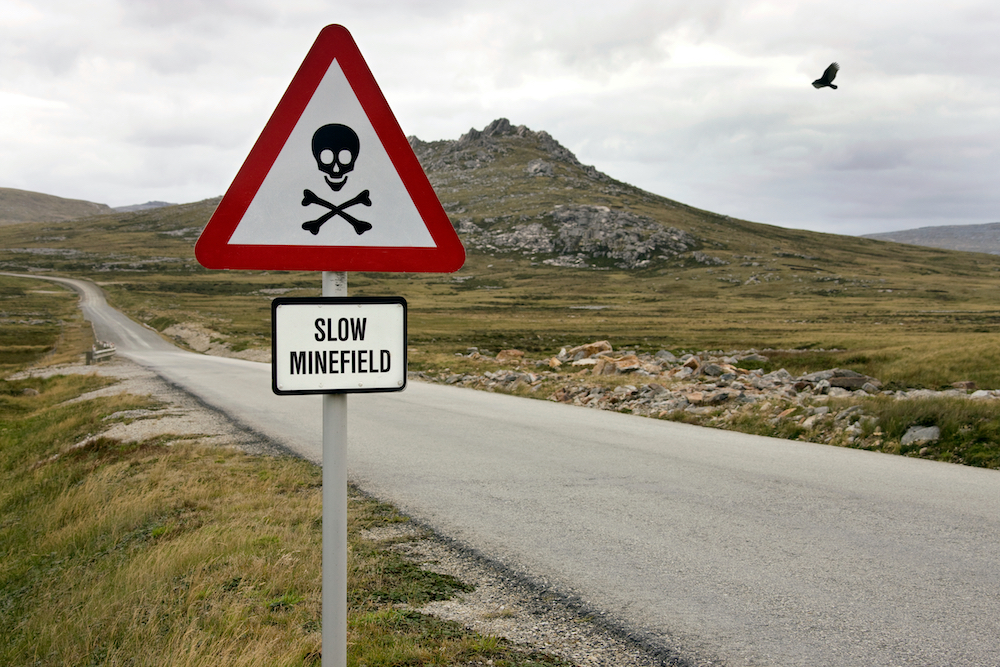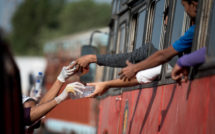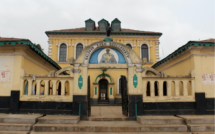

This is part of our special feature, Networks of Solidarity During Crisis.
This is part of our Campus Spotlight on Bennington College.
Landmine clearance is often approached as a technical problem: how do you remove a mine from the ground? Yet, landmines transform time, space, and people, as well as demonstrating much about life in the post-colonial, particularly the ways in which conflict uproots individuals and communities and reshapes their movement and sense of place, through both the presence of landmines and the act of landmine clearance.
Bennington College’s approach to student-driven interdisciplinary learning is, in many ways, ideally situated to interrogate objects like landmines because each student is required to set up a plan of study that transcends the disciplinary boundaries that constrict the ways in which we study the world we inhabit. Since the spring of 2019, a group of students at the college have been working to look ethnographically at landmines, landmine clearance, and the ways that landmines prevent refugees from returning to their homes, limit access to agricultural lands, divide communities from each other and otherwise reshape how people moved through their lived environments. The project began with a course that scrutinized the various academic approaches to landmines, and prepared the students to conduct ethnographic research in a series of sites, including Kosovo, Sri Lanka, Nepal, Afghanistan, India, and the Falklands Islands. Students and the faculty leader then spent parts of the summer of 2019 conducting research in these areas. This collaborative, interdisciplinary, ethnographic approach to landmines and the displacement they create help us begin to understand how landmines and landmine clearance reshapes the world. Some of the preliminary findings are discussed below.
Landmines
The over 100 million landmines deployed across the globe are estimated to kill 15,000 to 20,000 people a year.[1] Yet, landmines impact many, many more, displacing some communities, denying others access to farmland, reshaping social relations and impacting livelihoods. Despite this, the vast majority of literature on landmines is primarily technical, focused on landmine as the machinery of war. Less has been written on landmines as political and social objects that contribute to displacement and reshape the experience of place.
An exception to this, anthropologist Leah Zani, in her work on landmines in Cambodia, argues that:
Military waste produces its own culture and ecological patterns that only partially hew to geopolitical borders, while simultaneously manifesting a durability in the soil that frustrates geopolitical resolution. Military waste has no single front line or battleground, but instead manifests the layering and sedimentation of multiple conflicts over time within the same space.[2]
This lack of geographic bounding both demonstrates how landmines can contribute to long-term displacement and reorganization of social space, while also explaining why a comparative approach that transcends specific conflicts and territory is important. This project takes such an approach in order to highlight how landmines can change the ways in which we traditionally understand the temporal and spatial aspects of war, and how it relates to displacement and “post-conflict” settings (and how these settings relate to each other).
Anthropologist David Henig argues that landmines “reassign the wider landscape as the space designated for life, and “no-entry-land” as that designated for death.” Thus, landmines “are embedded in people’s everyday intimate interactions with the world they inhabit.” People must navigate these new spaces and confront various forms of displacement and replacement. These new understandings of space have both material and emotional consequences. Landmines are embedded in the landscape, which restricts movement, but they’re also embedded in the bodies of the people inhabiting that landscape, through injury and other means. Other than the physical danger of explosion when it comes to mines, this study of landmines thus focuses on “the emotional distress that the waste provokes in people who dwell alongside it.” In addition, it pays attention to “the knowledge, memories, daily practice and emotions of the people who must live in and with the afflicted areas.” Henig calls for studies on landmines to “pay attention to the affect and effect of military waste scattered across the landscape, and to the social life of the ruined space, buildings and other objects that outlive the conflict itself.”[3]
Anthropologist Anna Tsing reveals another perspective that focuses on contamination as collaboration. Tsing argues that “collaboration is work across difference,” and collaboration “leads to contamination.” We are all contaminated, the “evolution of our “selves” is already polluted by histories of encounter.”[4] It is also important to note that the “diversity which allows us to enter collaborations emerges from histories of extermination, imperialism, and all the rest.” But it is this contamination that “makes diversity.”[5] Our encounters with the environment, including landmines and minefields, lead to our transformation both as beings and as we move through space through both displacement and new understandings of the world which we inhabit.
Three cases
Taking these concepts into the field, we gathered some initial understandings of how landmines have impacted local populations and contributed to displacement through both the laying and the clearing of landmines.
Sri Lanka
The organization of landmine clearance in Sri Lanka reveals the complex relationship that landmine clearance organizations have with development and security contracting, and has deeply impacted the ways in which certain communities have been able to return after years of displacement and the resources available to them. In the minefields, in the Tamel areas of northern Sri Lanka, a variety of organizations work to clear the mines that remain from Sri Lanka’s civil war and allow communities which have been displaced to return. Each minefield has been assigned an international organization to clear it with the government nominally overseeing the process, but does little on a day to day basis. Organizations working in these areas, like HALO Trust, are difficult to classify. On one level the work they are doing is largely humanitarian, yet many of their employees are from a military background, and the organization structures of teams, with team leaders and medics, feels distinctly militarized. At the same time, local communities pressure groups to provide literacy courses and employment programs. The organization trumpets the number of war widows it has hired to locate munitions. Half private security firm, half aid organization and, in many ways, a replacement for the state, these organizations have refigured the politics of the areas that they are working in, as returnees rely on them for a variety of services.
Kosovo
Landmines in Kosovo were mainly laid by the Yugoslav and later Serbian regime, particularly near the border in order to discourage migration and to limit the ability of those opposed to the regime to move freely. During the Kosovo War they were also used to a limited extent by the Kosovo Liberation Army (KLA). The demining process is conducted mainly by the state and two other organizations (Norwegian People’s Aid and HALO Trust). Most of the deminers are former KLA soldiers. Interviewees suggest that landmines pose an obstacle to the ways of thinking about war. Rather than an outburst of violence, landmines are an example of the leftovers of it. In the case of Kosovo, they are not merely leftovers of war. They are imperial ruins, which not only reconceptualize war for those that have been impacted by the conflict, but are ruins of the Yugoslav Empire inscribed in the bodies of Kosovars and in the landscape of Kosovo.
Nepal
Landmines primarily impacted rural areas in Nepal, often placed at strategic pathways to limit the ability of those in rural areas to travel and either access state resources, or in the case of rebels, attack the government. The current celebration of a “landmine-free Nepal” is used by the government to produce a bureaucracy to reinforce the government’s own legitimacy. In Nepal, landmines therefore transcend their materiality and spatio-temporality and instead work as a tool to produce a bureaucracy which is critical to control and continue a particular narrative about the effectiveness and transparency of both the state and certain international bodies (such as the International Human Rights agencies). It orders and renders certain types of citizens visible and others invisible, reproducing a paternalistic state.
Landmines, clearance, displacement and return
Looking at these cases comparatively using interdisciplinary techniques, including ethnography, interviews and other modes of analysis, reveals some important trends that are often missed in more traditional studies.
Coverage of landmine clearance renders certain things visible and others invisible
International portrayals of landmine clearance often render certain aspects of a conflict visible, while erasing others. For instance, the involvement of “women and survivors,” who are targeted as participants in specific programs in Sri Lanka’s landmine clearance efforts, has helped the government to gloss over the thirty years of brutal war which used landmines to take lives and to maim hundreds and thousands of people, focusing attention on the clearance as a-political development. Simultaneously, the conflicts created by landmine clearance between local communities that are returning from their displacement is ignored in these narratives. Land is not simultaneously repopulated; instead, refugees return in waves, leading to disputes over land and property boundaries. These local conflicts, however, are almost always downplayed or ignored in most narratives about landmines. At other moments, such as during Princess Diana’s highly publicized visit to a minefield (and her son’s later reenactment of this visit), the benevolent image of outsiders simply clearing and restoring land for colonial subjects clashes with the reality that many of these landmines were produced by countries like Great Britain.
Landmine clearance bureaucratizes
Another way that landmines erase certain narratives is through bureaucratization. Land being given to returning refugees is often carefully surveyed to allow for better state control. Beyond this, however, since the public announcement of Nepal being “landmine-free,” reports about landmines in Nepal have been censored. Interviewees in the Nepali military showed reluctance to speak about landmines and instead would steer the conversation to the technical aspects of defusing bombs and other IEDs. This communicated an essential objective on the part of the state: to perpetuate the state as the protector of local communities. In fact, landmines in Nepal were mostly planted by the National Army, and thus the state was responsible for any and all of the landmine related deaths and injuries. On the other hand, home-made bombs and IEDs continue to be known to be the weapons of the Maoists. By deviating the conversation from landmines to technical aspects, the interviewees played a part in trying to bury the state’s role in injuries of war by emphasizing those only traceable back to the Maoists.
Landmines as Imperial Ruins
Landmines also continue processes of imperialism and oppression by serving as what anthropologist Ann Stoler calls imperial ruins. Imperial ruins, according to Stoler, are “relations of force;” they “harbor political forms that endure beyond the formal exclusions that legislate against equal opportunity, commensurate dignities, and equal rights.” Landmines are not simply leftovers from a dead regime, they continue to emit political power and shape the way in which people inhabit contaminated landscapes. They contribute, for example, to post-colonial refugee flows from south to north and to economic inequality, since it is often the poorest areas from which mines are removed last.
Stoler argues that ruination “is an act perpetrated, a condition to which one is subject.” There is intentionality in landmines beyond war, landmines as ruins are meant to continue destroying certain people and places after war ends and continue to do so even after the empire is long gone. They are “political projects” and to “think with the ruins of empire is to emphasize less the artifacts of empire as dead matter or remnants of a defunct regime than to attend to their reappropriations and strategic and active positioning within the politics of the present.”[6] Here contaminated landscapes can be reappropriated by the state as a way to nation-build and solidify the claim of a state over territory and subjects.
Imperial architecture also has imperial architects—therefore, an understanding of landmines as imperial ruins enables the seeking of accountability and justice. Imperial projects “are themselves processes of ongoing ruination, processes that “bring ruin upon,” exerting material and social force in the present.” Landmines, then, are meant to continue causing harm as part of such imperial projects. They are also “made but not just by anyone, anytime, or anywhere.” It is important to note that large-scale “ruin making takes resources and planning that may involve forced removal of populations and new zones of uninhabitable space, reassigning inhabitable space, and dictating how people are supposed to live in them.” Thus, “these ruin-making endeavors are typically state projects, ones that are often strategic.”[7] These projects are not simply contingent, or brought about by an unpredictable war, but create long lasting power structures that disenfranchise individuals and shape their day-to-day activities, such as movement, in profound manners.
Change the temporal/spatial nature of war
Finally, this research suggests that terms such as “post-conflict” mislead us from the actual everyday, continual violence created by landmines. Just because a war is “over” does not mean that landmines stop killing victims or that displaced communities can return to their homes. The violence of war continues. This violence is physical, in the maiming of individuals, but it is also structural: communities displaced due to landmines often have access to few resources and are treated as less than citizens.
Thus, this project reflects the ways in which interdisciplinary studies are necessary to understand the impact of landmines and the displacement they often create. We must look at how landmines can be defused, but also how they reshape political discourses and conflicts, often doing the most damage to disempowered communities that have had their worlds reshaped by these ruins of war. While there is clearly much to be done in the study of landmines and displacement, this small-scale project suggests that the ways into such conversations must take into consideration a range of perspectives and rely on a range of methodological tools, to ensure the violence of landmines is not simply reworked, allowing states to control land and the movement of the people who lived there.
Noah Coburn is a political anthropologist and faculty member at Bennington College. His research focuses on intervention, violence and politics in Central and South Asia. His most recent book is Under Contract: The Invisible Workers of America’s Global Wars.
Elbunit Kqiku is a student at Bennington College focusing on materiality and nonhuman agency and studies Anthropology. He has conducted field research in Kosovo and is currently working on his senior thesis on the intersection between landmines and empire.
Sitashma Parajuli is a student at Bennington College, from Kathmandu, Nepal. She studies Anthropology, Sociology, and Political Theory. Her research has been primarily on the topics of Forced Migration and Displacement in Nepal, Malaysia, and Jordan.
References:
David Henig, “Iron in the Soil: Living with Military Waste in Bosnia-Herzegovina,” Anthropology Today 28, no. 1 (2012).
Eleana J. Kim, “Toward an Anthropology of Landmines: Rogue Infrastructure and Military Waste in the Korean DMZ,” Cultural Anthropology 31, no. 2 (April 2016).
Ann Laura Stoler, “Imperial Debris: Reflections on Ruins and Ruination,” Cultural Anthropology 23, no. 2 (2008).
Anna Tsing (2015), The Mushroom at the End of the World: On the Possibility of Life in Capitalist Ruins (Princeton: Princeton University Press).
UNICEF, ‘Children and Landmines: A Deadly Legacy,’ https://www.unicef.org/french/protection/files/Landmines_Factsheet_04_LTR_HD.pdf,
Leah Zani (2019), Bomb Children: Life in the Former Battlefields of Laos (Durham: Duke University Press).
[1] UNICEF, ‘Children and Landmines: A Deadly Legacy,’ https://www.unicef.org/french/protection/files/Landmines_Factsheet_04_LTR_HD.pdf, accessed 13 November, 2019.
[2] Leah Zani (2019), Bomb Children: Life in the Former Battlefields of Laos (Durham: Duke University Press), 8-9.
[3] David Henig, “Iron in the Soil: Living with Military Waste in Bosnia-Herzegovina,” Anthropology Today 28, no. 1 (2012): 23. https://doi.org/10.1111/j.1467-8322.2012.00851.x,
[4] Anna Tsing (2015), The Mushroom at the End of the World: On the Possibility of Life in Capitalist Ruins (Princeton: Princeton University Press).
[5] Ibid.
[6] Ann Laura Stoler, “Imperial Debris: Reflections on Ruins and Ruination,” Cultural Anthropology 23, no. 2 (2008): 193, 195-96.
[7] Ibid.
Photo: Minefield Sign near Stanley, the capital of the Falkland Islands (Islas Malvinas). Large areas remain unsafe following the Falklands War, a 10-week undeclared war between Argentina and Britain | Shutterstock
Published on October 13, 2020.




